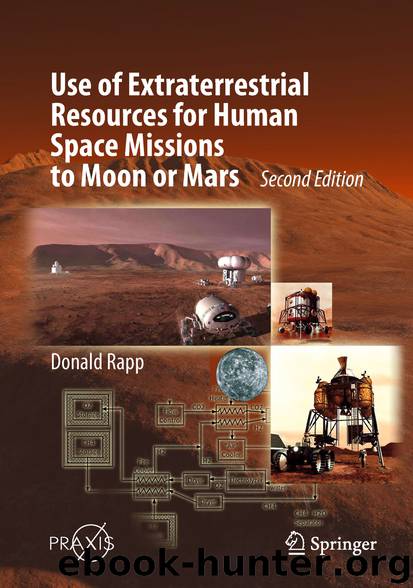Use of Extraterrestrial Resources for Human Space Missions to Moon or Mars by Donald Rapp

Author:Donald Rapp
Language: eng
Format: epub
Publisher: Springer International Publishing, Cham
The above four-step mechanism shows that if the reaction is not arrested at step 3, and step 4 takes place, one would get a very poor conversion to C2H4. The catalytic system design should then be such that steps 1–3 are carried out efficiently, but step 4 is frozen. This can be accomplished by a reaction scheme that employs a molecular sieve based trap to remove (and thus protect) the ethylene before it can be oxidized. Such a scheme would avoid step 4 and thus provide a high C2H4 selectivity. Ethylene can be recovered later from the adsorbent trap by heating. This process also requires recirculation of reaction products so that more and more ethylene is trapped out on the sieve with each pass through the reactor.
Some catalysts can convert methane to ethylene and other higher hydrocarbons directly, without going through the oxidative route. The penalty is an increased energy requirement, due to an endothermic heat requirement of 221.5 kJ/mol (53 kcal/mol). Reasonably good selectivities for higher hydrocarbons have been obtained, but methane conversions were unacceptably low (around 10%).
Thermodynamic temperature limitations for methane conversion to higher hydrocarbons can sometimes be circumvented by using a two-step process. In this approach, a catalyst is chosen that can activate the CH4 molecule (for C–C coupling) at a low temperature. If this step is rate-limiting, the actual coupling to higher hydrocarbons occurs in the second step. In practice, this approach has had only a partial success.
Conversion of methane to benzene has been studied in detail by several investigators. In general, selectivities of 65–90% have been obtained, but conversion yields were only in the 7–12% range. The prospects for conversion of methane to benzene do not look too good because of low yields.
After reforming methane with carbon dioxide to produce carbon monoxide and hydrogen, further reactions can lead to higher organic products. For example the Fischer-Tropsch synthesis involves conversion of CO and H2 to straight-chain alkanes:
Download
This site does not store any files on its server. We only index and link to content provided by other sites. Please contact the content providers to delete copyright contents if any and email us, we'll remove relevant links or contents immediately.
| Aerodynamics | Aircraft Design & Construction |
| Astronautics & Space Flight | Avionics |
| Gas Dynamics | Propulsion Technology |
Whiskies Galore by Ian Buxton(40329)
Introduction to Aircraft Design (Cambridge Aerospace Series) by John P. Fielding(32338)
Small Unmanned Fixed-wing Aircraft Design by Andrew J. Keane Andras Sobester James P. Scanlan & András Sóbester & James P. Scanlan(32141)
Craft Beer for the Homebrewer by Michael Agnew(17445)
Turbulence by E. J. Noyes(7037)
The Complete Stick Figure Physics Tutorials by Allen Sarah(6638)
Kaplan MCAT General Chemistry Review by Kaplan(6053)
The Thirst by Nesbo Jo(5785)
Bad Blood by John Carreyrou(5768)
Learning SQL by Alan Beaulieu(5410)
Weapons of Math Destruction by Cathy O'Neil(5036)
Man-made Catastrophes and Risk Information Concealment by Dmitry Chernov & Didier Sornette(4735)
iGen by Jean M. Twenge(4702)
Digital Minimalism by Cal Newport;(4540)
Life 3.0: Being Human in the Age of Artificial Intelligence by Tegmark Max(4507)
Audition by Ryu Murakami(4098)
1,001 ASVAB Practice Questions For Dummies by Powers Rod(4038)
Electronic Devices & Circuits by Jacob Millman & Christos C. Halkias(4027)
Pale Blue Dot by Carl Sagan(4001)
